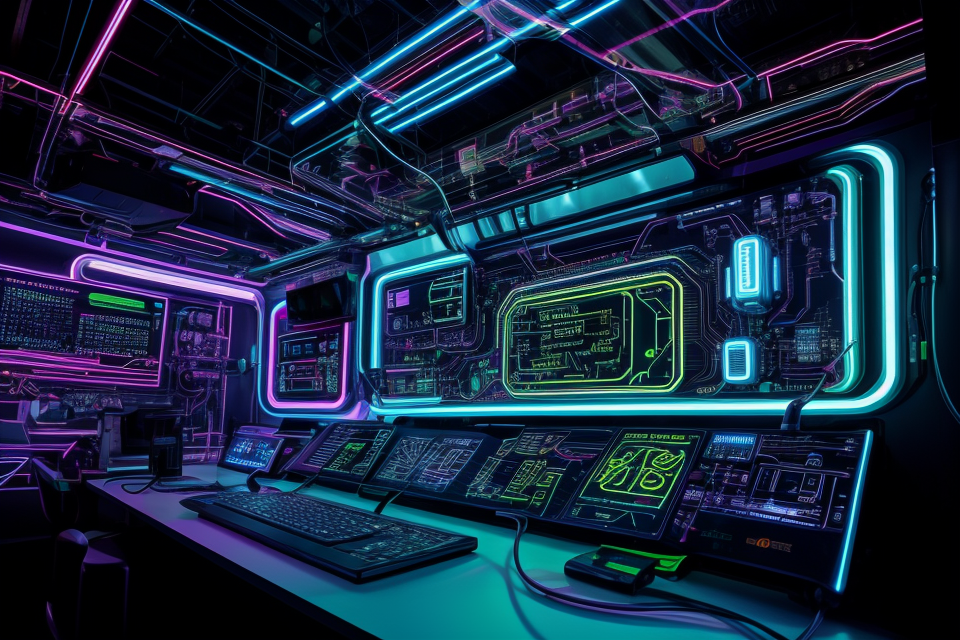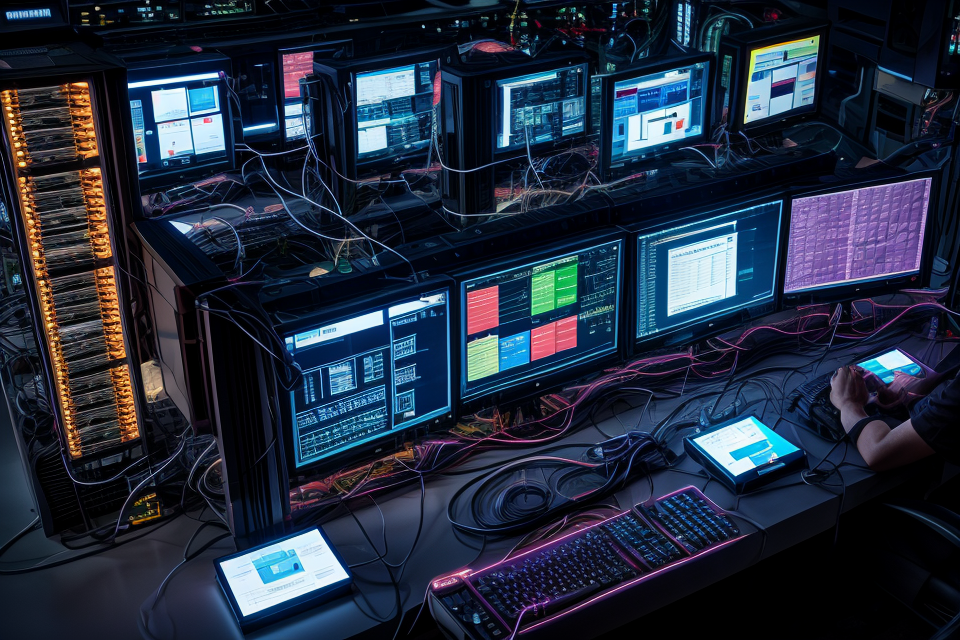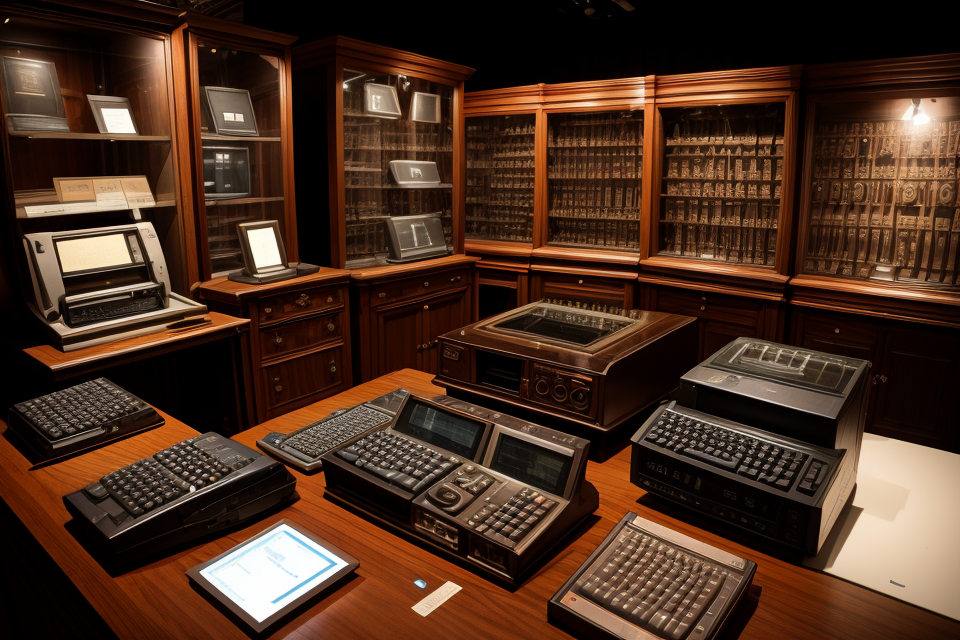
Ever wondered how a computer, a machine so integral to our daily lives, gets its power? It’s a question that may seem simple, but the answer is far from it. Computers are incredibly complex machines that require a lot of power to function. From the CPU to the hard drive, each component relies on a steady flow of electricity to operate. But how do computers harness this power? In this article, we’ll take a closer look at the different ways computers get their energy, and explore the technology that makes it all possible. So, let’s dive in and discover the fascinating world of computer power!
Computers harness power through a combination of hardware and software. Hardware includes the physical components of a computer, such as the CPU, memory, and storage devices, which process and store data. Software, on the other hand, includes the operating system and applications that provide the instructions for the hardware to execute. The power supply unit (PSU) is responsible for converting the alternating current (AC) from the wall outlet into the direct current (DC) that the computer’s components require. The PSU also regulates the voltage and amperage to ensure that the components receive the correct amount of power. The combination of hardware and software allows computers to perform a wide range of tasks, from simple calculations to complex operations such as image and video processing, data analysis, and machine learning.
The Fundamentals of Computer Power
Understanding Voltage and Current
Voltage and current are two key components that play a crucial role in powering a computer. Voltage refers to the electrical potential difference between two points, while current is the flow of electric charge through a circuit. In simpler terms, voltage is the pressure that pushes electricity through a circuit, while current is the amount of electricity that flows through that circuit.
When it comes to computers, the voltage used is typically Direct Current (DC) power, which is a type of electricity that flows in one direction. This is because DC power is easier to regulate and is less prone to electrical surges, which can damage computer components.
On the other hand, Alternating Current (AC) power is the type of electricity that is used in most homes and businesses. AC power is obtained from the power grid and is commonly used to power appliances and electronic devices. However, AC power is not suitable for use in computers because it is more difficult to regulate and can cause damage to computer components.
In summary, understanding the differences between voltage and current is essential when it comes to powering a computer. While both components are important, DC power is the preferred choice for computers because it is easier to regulate and less prone to causing damage to computer components.
The Power Supply Unit (PSU)
The Power Supply Unit (PSU) is a crucial component in a computer’s power supply system. It is responsible for converting the alternating current (AC) from the wall outlet into the direct current (DC) that is required by the computer’s components. The PSU also regulates the voltage and amperage of the power supplied to the computer‘s various components, ensuring that they receive the correct amount of power needed to function properly.
Functions of a PSU:
- Converting AC to DC: The PSU converts the AC power from the wall outlet into DC power that can be used by the computer’s components.
- Voltage Regulation: The PSU regulates the voltage of the power supplied to the computer‘s components, ensuring that they receive the correct voltage needed to function properly.
- Amperage Regulation: The PSU also regulates the amperage of the power supplied to the computer‘s components, ensuring that they receive the correct amperage needed to function properly.
- Protection: The PSU also provides protection against power surges, spikes, and other electrical abnormalities that can damage the computer’s components.
Choosing the right PSU for your computer:
- Wattage: The wattage of the PSU should match the wattage requirements of the computer’s components.
- Form Factor: The PSU should fit into the computer case and match the form factor of the case.
- Efficiency: The PSU should be efficient, as this will help to reduce the amount of heat generated by the PSU and improve the overall performance of the computer.
- Brand and Reputation: It is important to choose a reputable brand for the PSU, as this will help to ensure that the PSU is of high quality and will provide reliable power to the computer’s components.
Computer Power Consumption
Power Usage and Efficiency
When it comes to power usage and efficiency, there are several factors that can impact how much energy a computer consumes. One of the most important factors is the type of components used in the computer. Different components have different power requirements, and some components are more energy-efficient than others.
For example, a high-performance graphics processing unit (GPU) can consume a significant amount of power, while a low-power processor may consume much less energy. In addition, the amount of power a computer consumes can also be impacted by the operating system and the type of applications running on the computer.
Another important factor to consider is energy efficiency. As the world becomes increasingly concerned with sustainability and reducing carbon emissions, energy efficiency is becoming an increasingly important consideration for computer users. Fortunately, many computer manufacturers are now designing their products with energy efficiency in mind, using advanced technologies to reduce power consumption and minimize the environmental impact of computing.
One way that computers can harness power more efficiently is through the use of sleep mode. When a computer is in sleep mode, it is not actively being used, but it is not completely shut down. Instead, the computer enters a low-power state in which it can quickly wake up and resume operation when needed. This can help reduce power consumption and extend the lifespan of the computer’s components.
Another way that computers can harness power more efficiently is through the use of virtualization. Virtualization allows multiple operating systems and applications to run on a single physical machine, reducing the number of machines that need to be powered on and the amount of energy consumed.
Overall, power usage and efficiency are important considerations for anyone who uses a computer. By choosing energy-efficient components, using sleep mode, and taking advantage of virtualization, it is possible to reduce power consumption and minimize the environmental impact of computing.
The Role of Operating Systems
Operating systems play a crucial role in managing the power consumption of computers. They are responsible for controlling the flow of electricity to various components within the system, including the CPU, GPU, memory, and storage devices. The primary goal of an operating system is to balance the power requirements of different components to ensure optimal performance while minimizing energy waste.
One of the key ways that operating systems manage power consumption is through the use of power states. A power state is a specific mode of operation that determines the level of activity within a computer system. There are typically several power states, ranging from full power to deep sleep, and each state has a different level of power consumption.
When a computer is inactive, the operating system can lower the system’s power consumption by placing it in a low-power state. In this state, the system’s clock speed is reduced, and the voltage supplied to the CPU and other components is lowered. This results in a significant reduction in power consumption, which can help to extend the battery life of laptops and other portable devices.
In addition to managing power states, operating systems also employ various techniques to optimize power usage. For example, modern operating systems use a technique called dynamic frequency scaling, which adjusts the clock speed of the CPU based on the workload. When the system is idle or performing light tasks, the CPU clock speed is reduced, which reduces power consumption. When the system is performing more demanding tasks, the CPU clock speed is increased to provide better performance.
Another technique used by operating systems to optimize power usage is called power capping. This technique involves limiting the maximum power consumption of the CPU and other components to a specified level. This can help to prevent excessive power consumption and thermal dissipation, which can lead to reduced performance and reliability issues.
Overall, the role of operating systems in managing power consumption is critical to the overall energy efficiency of computers. By optimizing power usage through techniques such as power states, dynamic frequency scaling, and power capping, operating systems can help to reduce energy waste and extend the lifespan of computer components.
Powering Devices: Wired and Wireless
Wired Power
Wired power is a reliable and efficient method of providing electricity to computers and other devices. One of the main benefits of using wired power is that it is more stable and less prone to interference compared to wireless power sources. This means that devices connected to a wired power source are less likely to experience disruptions or drops in power, which can affect the performance and stability of the device.
Setting up wired power for your computer is relatively simple. Most computers have a power supply unit (PSU) that is built into the case, and this PSU has multiple connectors for different components such as the motherboard, graphics card, and hard drive. To set up wired power, you will need to connect the appropriate cables from the PSU to the components in your computer. Typically, this involves connecting the 24-pin ATX power cable to the motherboard, and any additional cables for other components such as the graphics card or hard drive.
Once you have connected all the necessary cables, you can plug the power supply into a wall outlet and turn on your computer. Your computer should now be receiving power through a wired connection, which can provide a stable and reliable source of electricity for your device.
Overall, wired power is a convenient and efficient way to power computers and other devices. It offers a stable and reliable source of electricity, and is relatively easy to set up. By using wired power, you can ensure that your device is receiving a consistent and uninterrupted supply of power, which can help to improve its performance and stability.
Wireless Power
Wireless power technology has revolutionized the way devices are charged. With the advent of wireless charging, users no longer have to deal with tangled cords or worry about remembering to charge their devices. This section will provide an overview of wireless power technologies and discuss how devices can be charged wirelessly.
Overview of Wireless Power Technologies
Wireless power technology refers to the transfer of electrical energy from one device to another without the use of wires. There are several types of wireless power technologies, including electromagnetic induction, resonant inductive coupling, and radio frequency (RF) transmission.
Electromagnetic Induction
Electromagnetic induction is a method of wireless power transfer that uses an electromagnetic field to transfer energy between two devices. One device, known as the transmitter, generates an electromagnetic field, which is then used to induce a current in a receiving device. This current can then be used to charge a battery or power the device directly.
Resonant Inductive Coupling
Resonant inductive coupling is another method of wireless power transfer that uses a resonant circuit to transfer energy between two devices. The transmitter and receiver are equipped with resonant circuits that are tuned to the same frequency. When the transmitter is activated, it generates an electromagnetic field that induces a current in the receiving device. This current can then be used to charge a battery or power the device directly.
Radio Frequency (RF) Transmission
Radio frequency (RF) transmission is a method of wireless power transfer that uses RF waves to transfer energy between two devices. The transmitter sends RF waves to the receiving device, which then converts the RF energy into DC energy to charge a battery or power the device directly.
Charging Devices Wirelessly
Wireless power technology has made it possible to charge devices without the need for physical contact. This is particularly useful for devices that are difficult to charge, such as smartphones and wearables. Many devices now come with built-in wireless charging capabilities, and there are also a variety of wireless charging pads and stands available for use at home or in the office.
Wireless power technology has also enabled the development of new applications, such as wireless charging for electric vehicles. This technology allows electric vehicles to be charged wirelessly while parked, eliminating the need for a charging cable.
In conclusion, wireless power technology has revolutionized the way devices are charged, providing users with a convenient and hassle-free charging experience. With the continued development of this technology, it is likely that wireless charging will become even more widespread in the future.
The Future of Computer Power
Emerging Technologies
As technology continues to advance, so too does the way computers harness power. Emerging technologies are constantly being developed to improve the efficiency and effectiveness of power delivery in computers.
Trends in computer power
One trend in computer power is the move towards more energy-efficient processors. This is achieved through the use of smaller transistors and improved manufacturing techniques, which allow for more power to be delivered with less energy consumed. Additionally, the use of multi-core processors is becoming more prevalent, allowing for more efficient use of power and better performance.
Innovations in power delivery
Another trend in computer power is the development of new methods for delivering power to computers. One example is the use of solid-state drives (SSDs) which use less power than traditional hard disk drives. Additionally, the use of USB Type-C connectors is becoming more common, as they are capable of delivering both power and data to devices. This allows for more efficient use of power and easier charging for devices.
Overall, emerging technologies in computer power are focused on improving efficiency and reducing energy consumption while maintaining or even improving performance. These trends are likely to continue as technology advances and the demand for more powerful and energy-efficient computers grows.
Sustainability and the Environment
- The impact of computer power on the environment
- Computers require a significant amount of energy to operate, leading to a large carbon footprint
- This contributes to climate change and has a negative impact on the environment
- Green computing initiatives
- Initiatives aimed at reducing the environmental impact of computers
- These include using renewable energy sources, implementing energy-efficient technologies, and recycling electronic waste
- There is also a focus on designing computers that are more sustainable and have a longer lifespan
- Additionally, some companies are working on developing new materials and technologies that can reduce the energy consumption of computers
- Governments and organizations are also playing a role in promoting sustainable computing practices, through policies and programs aimed at reducing e-waste and increasing the use of renewable energy in data centers.
FAQs
1. How is a computer powered?
Computers are powered by electricity. The electricity is used to power the various components of the computer, such as the central processing unit (CPU), memory, and storage devices. The electricity is typically provided by an external power source, such as a wall outlet, or by a battery.
2. What types of power sources can be used to power a computer?
There are several types of power sources that can be used to power a computer, including:
* An external power adapter, which plugs into a wall outlet and provides power to the computer
* A battery, which is used to power the computer when it is not connected to an external power source
* A power supply unit (PSU), which is a device that converts the voltage of the electricity to the voltage required by the computer’s components
3. How does a computer convert electricity into usable energy?
A computer converts electricity into usable energy through the use of a power supply unit (PSU). The PSU takes in the electricity from an external power source or battery and converts it to the voltage and current required by the computer’s components. The PSU then distributes this power to the various components of the computer, such as the CPU, memory, and storage devices, allowing them to function.
4. Can a computer be powered by renewable energy sources?
Yes, a computer can be powered by renewable energy sources such as solar or wind power. This is typically done by using a power adapter that is connected to a solar panel or wind turbine, which generates electricity that is then used to power the computer.
5. How can I conserve power when using my computer?
There are several ways to conserve power when using your computer, including:
* Shutting down your computer when you are not using it, rather than leaving it in sleep mode
* Using energy-efficient settings, such as turning off the display when the computer is in sleep mode
* Using a power strip to easily turn off all of the components of the computer at once, rather than turning them off individually
* Using a power-efficient CPU and memory, which consume less power than standard components.


